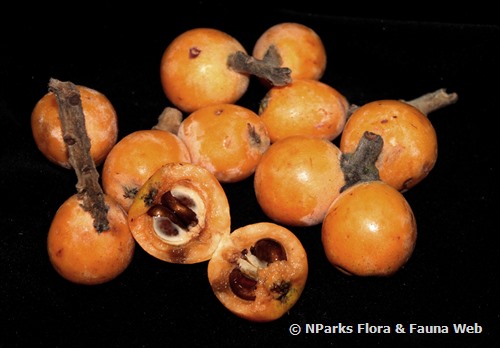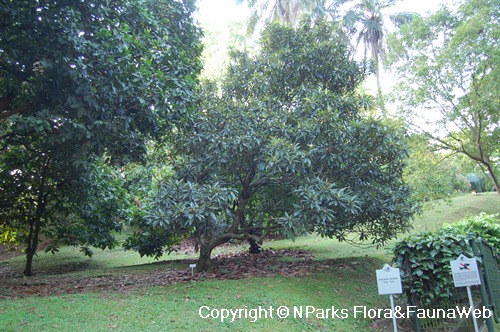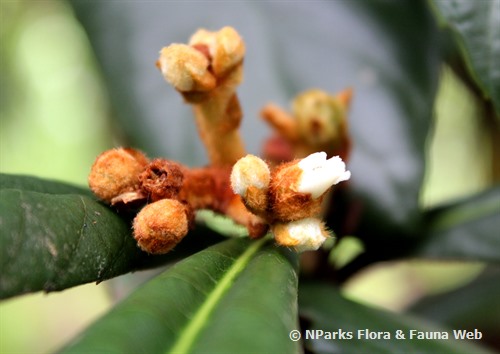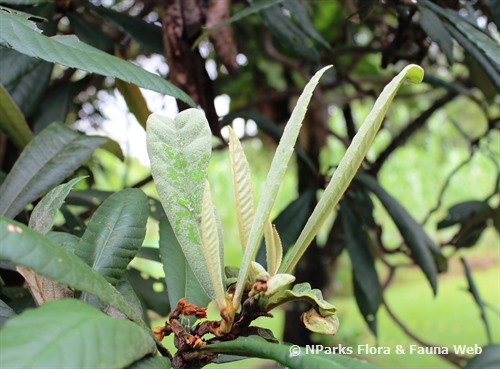
Back
Eriobotrya japonica (Thunb.) Lindl.
| Family Name: | Rosaceae |
| Common Name: | Loquat, Japanese Loquat, Japanese Medlar, Nispero, Japanese Plum, 枇杷, 卢桔 |
Name
Classifications and Characteristics
| Plant Division | Angiosperms (Flowering Seed Plants) (Dicotyledon) |
|---|---|
| Plant Growth Form | Tree (Small (6m-15m)) |
| Lifespan (in Singapore) | Perennial |
Biogeography
| Native Distribution | China, Japan |
|---|---|
| Native Habitat | Terrestrial |
| Preferred Climate Zone | Sub-Tropical / Monsoonal, Temperate |
Description and Ethnobotany
| Growth Form | Eriobotrya japonica is a small-sized tree growing up to 10 m tall. |
|---|---|
| Foliage | Its short-stemmed leaves are elliptic-lanceolate, measuring 10 to 30 cm long with toothed margins. The upper surfaces of the leaves are glabrous while the lower surfaces are covered with brownish hairs. |
| Flowers | Its white flowers are born in clusters in the terminals of the branches. The stems and sepals are covered with rusty, brownish hairs. |
| Fruit | Its fruits are globose to elliptical, about 5 cm in diameter. The fruit skin is hairy, turning from green to gold when ripe. There are 1 to 5 seeds in each fruit. |
| Etymology | The specific epithet japonica means of or from Japan, referring to its native range. |
| Ethnobotanical Uses | Edible Plant Parts : Edible Fruits Food (Fruit or Vegetable): The loquat fruit can be eaten fresh or canned. The fruit skin can be easily peeled off when fully ripe. Medicinal: The leaves of Eriobotrya japonica are used to treat cough and throat inflammation in China. |
Landscaping Features
| Desirable Plant Features | Ornamental Fruits, Fragrant (Flowers) |
|---|---|
| Landscape Uses | Parks & Gardens |
| Thematic Landscaping | Economic Garden |
Plant Care and Propagation
| Light Preference | Full Sun |
|---|---|
| Water Preference | Moderate Water |
| Plant Growth Rate | Moderate |
| Rootzone Tolerance | Well-Drained Soils, Fertile Loamy Soils |
| Propagation Method | Seed, Grafting |
Foliar
| Mature Foliage Colour(s) | Green |
|---|---|
| Mature Foliage Texture(s) | Hairy / Hirsute |
| Leaf Area Index (LAI) for Green Plot Ratio | 3.0 (Tree - Intermediate Canopy) |
Floral (Angiosperm)
| Flower Colour(s) | White |
|---|---|
| Flower Grouping | Cluster / Inflorescence |
Fruit, Seed and Spore
| Mature Fruit Colour(s) | Yellow / Golden |
|---|---|
| Mature Seed Colour(s) | Brown |
| Mature Seed Texture(s) | Smooth |
| Seed Quantity Per Fruit | Few (1-5) |
Image Repository
Others
| Master ID | 1585 |
|---|---|
| Species ID | 2878 |
| Flora Disclaimer | The information in this website has been compiled from reliable sources, such as reference works on medicinal plants. It is not a substitute for medical advice or treatment and NParks does not purport to provide any medical advice. Readers should always consult his/her physician before using or consuming a plant for medicinal purposes. |




